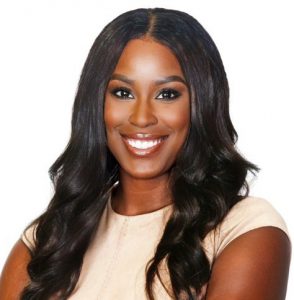Despite how far we’ve come in terms of workplace inclusivity and supporting the professional advancement of women, they still remain underrepresented in corporate leadership — especially women of color. While women now account for almost half of the workforce in entry-level roles, according to a recent McKinsey & Company study of more than 65,000 women (and 423 companies employing more than 12 million people), they filled only 24% of C-suite positions in 2021 — just a small increase (from about 19%) from 2016. The study also found that women only made up around 30% of senior vice president and vice president roles in 2021, a gain of just a few percentage points from 2016.
And women of color are getting an even shorter end of the stick — with representations across the board falling much lower than white men, white women, and men from underrepresented groups. Women of color accounted for just 4% of C-suite positions in 2021 (while men of color made up 13%), and 5% and 7% of senior vice president and vice president roles, respectively, (while men of color held 12% and 13% of those roles, respectively).
There is no quick or easy fix to the systemic issue of gender inequality — and it will continue to take time to truly change the narrative around women in the workforce. But what work can early talent recruiters and Diversity and Inclusion (D&I) champions do to help move the needle on supporting women as they climb the ranks to leadership positions? According to a panel RippleMatch hosted earlier this month, they can (1) leverage data to track their company’s progress in recruiting and empowering women, (2) support the training of their company’s managers to better nurture female talent as well as offer professional development opportunities for women, and (3) make meaningful partnerships with groups that advocate for women in the workforce.
In our March Talent Talk, we discussed how to recruit, retain, and empower women in your organization with three talent acquisition leaders from Confluent, Deutsch NY, and PepsiCo. The panelists, Monique Aristy, Celeste Bell, and Naneth Allen shared strategies that brought promising female talent into their organization, and shared how they pursue organization-wide buy-in to keep and uplift female talent.
You can watch the panel replay below, and read on for themes that arose during the discussion.
Recruiters Should Set Goals and Leverage Data to Make Change.
The panelists emphasized that bringing more women into the workforce and helping them advance is an attainable goal — as long as you dedicate the proper resources to setting and meeting your objectives around supporting female talent.
But how do you set those objectives and track your progress over time? According to the panelists, the answer is to collect data — and collect it often. Presenting leadership with market data about female representation in your industry and internal data on women in your talent pipeline can help highlight areas for growth and renewed focus.
Here’s data you can collect and leverage at every stage of the recruitment/retainment process:
- Your D&I strategy should be informed by clear, tangible goals. Taking a look at the labor market, make an educated decision about how many spots you should reserve for female candidates.
- What schools graduate the most female talent with majors related to your company’s work? Do your research to make a case for where you should focus your efforts.
- Women’s workplace preferences differ from their male counterparts. Take a look at data out there on what matters to female Gen Z candidates as you plan your recruitment marketing strategy.
- Once you’ve recruited and placed female talent, send out onboarding surveys to track how new female hires are adjusting and make changes to that process based on their responses.
- Send out quarterly surveys to female employees to gauge how they are perceiving the workplace and their managers, and get an idea for how many women are being promoted in your company. Are they being overlooked for leadership positions? Do they need extra coaching to help them grow professionally?
- Use exit interviews with female employees to learn what your company could do better to support women in your organization.
Your survey results, research, and numbers may show that you are meeting your goals around female talent and your employees are satisfied. But as one panelist put it, system-wide change doesn’t happen when you remain at the status quo and don’t make efforts to improve. Just because your employees may not have negative things to say about your company, it doesn’t mean you shouldn’t constantly be reevaluating your goals and trying to empower women in your company to a greater degree.
Companies Should Offer Professional Development for Managers & Female Employees, and Benefits to Support Them.
Once you’ve set goals and successfully gotten women in the door at your company, how do you retain them and help them fill higher roles? The panelists agreed that the next step is ensuring you have the proper support system in place to nurture every kind of employee. And that starts with taking a hard look at your managers.
Train managers to better support talent
When employees don’t have managers who champion them in the workplace, take an active role in helping them develop their skills, and push them to advance in the company, they don’t stick around. While this holds true for all employees, it may be one reason that female employees specifically are still severely underrepresented in the C-suite and in higher roles. Panelists shared that some of their companies have created training programs for managers to ensure that they are prepared to support and nurture employees who report to them, and are aware of employees who may need extra encouragement to pursue promotions. In lieu of a formal training program, you can also pair newer or struggling managers with more seasoned leaders to learn first-hand how to tend to their employees’ needs.
Once your managers are on board to support the growth of female employees, keep the momentum going by pushing your company to offer professional development opportunities for women in the office.
Show women what they need to do to advance their careers
If you want women — or any employee — to pursue higher roles in your company, it would benefit you to lay out the process for receiving a promotion. Panelists shared that some of their companies host events for all employees in which they explain exactly what employees need to do to advance to a higher role to eliminate any confusion or the perception that growth is unattainable. Focusing more on diverse talent, one panelist shared that her group hosts panels in which women and employees from underrepresented groups in high roles are invited to share their career stories and advice to others like them seeking advancement.
Set women up with female mentors and ERGs
The panelists also emphasized the importance of setting female employees or interns up with relatable mentors in the company — such as those part of your company’s Employee Resource Group (ERG) for women — who can share their career stories about how they climbed the ranks within your company. This can be done through formal mentorship programs or more organically, such as by hosting events where newer female hires can meet more seasoned employees in a low-pressure environment.
Allow women to network with each other
The panelists also discussed the power of allowing women in your industry to build a network with each other and form a community of female employees — especially in those industries that are dominated by men. You can give women the chance to come together by inviting them to events with women across the company — and even across the country if your organization is global — or by paying for them to attend conferences for women in your industry. In addition to being able to share concerns and successes with like-minded individuals, women who are given the chance to network may also find themselves connecting with mentors outside your company, to whom they may feel even more comfortable discussing their professional growth.
Acknowledge the workplace stress that falls more heavily on women
You may have the support systems in place to empower women — but does your company’s policies and benefits reflect the inclusive culture you’re working hard to promote? Women have experienced feelings of burnout in the workplace at much higher rates than men. Over the course of the COVID pandemic, one in three women considered quitting their job or downsizing in their work responsibilities due to stress and exhaustion, according to the McKinsey study. On top of professional development opportunities, ensure that your company is working to help alleviate the work-related pressure that has been found to affect women to a greater degree by offering benefits that support them and their families. Those measures might include flexible work schedules, the ability to work from home in fully- or hybrid-remote roles, and paid parental leave, among others.
Organizations Can Make Meaningful Partnerships With Organizations That Support Women.
Establishing partnerships with organizations that support women in the workplace will allow you to both expand your pipeline for diverse talent, as well as support the females within your walls. You can attend conferences to meet top female candidates in your industry, while demonstrating to your female hires that you care about building a more inclusive workforce by seeking more female talent. You can also support employees’ personal involvement in different organizations to show that you care about their personal and professional growth.
Below are some groups you can explore as partners that our panelist mentioned. (While some of the organizations listed are not specifically targeted at women, they still empower female talent.)
Black Girls Who Code – A nonprofit organization educating Black girls interested in coding
Grace Hopper Celebration – A global conference for women in technology
Management Leadership for Tomorrow – A nonprofit organization that provides professional development opportunities and advocates for people from underrepresented groups
National Society of Black Engineers – One of the largest student-governed organizations in the world that brings together Black engineers
She Runs It – A nonprofit organization supporting women in media, marketing, and tech
Society of Women Engineers – An international nonprofit that serves women in tech and engineering
Women Who Code – An international nonprofit for women pursuing careers in tech
Women Who Create – An organization with the goal of increasing retention, gender and ethnic diversity, and number of women in leadership positions in creative industries
Above All, It’s Important to Take a Holistic Approach to Recruiting.
A focus on attracting female talent is important — and it’s a huge step in the right direction when it comes to creating a more inclusive workforce. But the panelists emphasized that it should be viewed as just one part of your D&I strategy.
For example, one panelist offered, instead of dedicating all of your resources to attending conferences aimed at bringing together female talent, make sure that you are also spending time building relationships with diverse populations. While you may want to attend the Grace Hopper Celebration, don’t view it as a replacement for visiting campuses with diverse populations, hosting virtual open houses for those students, and reaching out to student groups to host or sponsor their events.
Change is happening —- more women are joining the workforce and entering fields formerly dominated by men. Relative to how many women are breaking into innovative industries, however, they still fall extremely behind in climbing the ranks to higher positions. Recruiting female hires and exposing them to new industries is the first step in the process of empowering women, but if they are not supported in the workplace that’s where they’ll stay — as new hires in entry-level roles at different companies. To retain and empower women once you get them in the door, you need to follow up with ensuring your company has a support system in place for those hires, such as strong managers, networking opportunities, and partnerships with groups dedicated to women in the workforce.
.png?versionId=ZO3nM6g69QL9DzKlSQlsUEBmSTDG5REe)

















